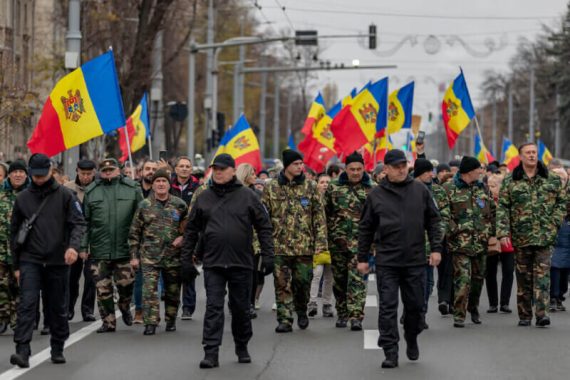R
ecently, people in Moldova feel threatened by a possible Russian attack. Concerns have grown over Moscow’s possible plans to use the country as a launchpad for an incursion into Ukraine.
Moldovans, government officials and people alike, are worried that Russia might destabilize the country, especially through the autonomous Transdniestria region, where Moscow has 1,500 troops stationed.
Why Transdniestria is important
The Transdniestria region is a breakaway Moldovan province located to the east of the country.
Russians constitute the region’s main ethnic group (30% of the population), followed by Moldovans (28%), and Ukrainians (22%). The rest includes Romanians and other smaller groups that do not specify nationality.
The Transdniestria region broke away from Soviet Moldova in 1990. Following the demise of the USSR in 1991, the Moldovan government forces and the pro-Russian secessionists fought each other.
Transdniestria’s self-declared government is not recognized by the international community but backed by Russia militarily and economically.
The referendum in September 2006, recognized by neither Moldova or the international community, embodied Transdniestria’s willingness to be annexed by Russia.
In 2014, the Transdniestria parliament urged Russia to recognize its independence—a call left unanswered by the latter.
Nevertheless, the region has its own administration, currency, constitution, flag, national anthem, police, and postal services.
Today, the Transdniestria issue poses a grave threat to Moldova’s unity and development, and undermines efforts to establish regional peace.
Historical background
After World War II, Russia determined Moldova’s future based on two regions: the heavily Russian-spoken Dniester region, and the Bessarabia region, which came under Romanian rule between 1918 and 1940.
When the USSR was on its deathbed, alarm bells rang over rising Moldovan nationalism. The 1989 law that made Moldovan an official language escalated tensions and the region broke away in September 1990.
Transdniestria’s paramilitary troops seized Moldovan institutions in 1991. The battle took place on the Dniester River in June 1992.
Fighting was aggravated by the successive declarations of independence from the USSR, and Moldova’s entry into the UN. Nearly 700 people were killed in the battles.
A ceasefire was reached in July 1992, and a demilitarized security zone was formed. The arrangements were overseen by the Russian troops in the area.
Russian clout in Transdniestria
The ongoing presence of Russian troops in the region impedes the development of peace talks. The Russian withdrawal began in 2001 but came to a halt when Transdniestria impeded the transfer of weapons.
Negotiations were brokered by the Organization for Security and Co-operation in Europe (OSCE), Ukraine, and Russia, but no tangible solution was reached.
Transdniestria is home to most of the industrial infrastructure of Moldova, but remains economically weak due to international sanctions.
Russia backs Transdniestria, which is reputed to have rampant inflation and a high rate of organized crime, with economic aid.
According to Gulru Gezer, a former Turkish diplomat, Russia’s main purpose is to prolong the conflict and prevent Moldova’s integration into the West. “Russia’s influence is not restricted to this region. Ever since Moldova’s independence, Russia has intervened in the elections and promoted the settlement of pro-Russian politicians in politics,” she added.
Moldova-EU relations
Moldova-EU relations date back to the 1994 Association Agreement, which was renewed in 2014, lifting the visa regime for Moldovan citizens arriving in the EU.
This drew the ire of Moscow, which imposed sanctions on goods imported from Moldova.
However, Moldova officially declares that it has not deviated from its balancing policy between Russia and the West. The government called for cooperation with Russia in resolving the Transdniestria crisis.
In 2020, pro-Western president Maia Sandu was elected, and pro-Russian forces, by and large, were neutralized.
Moldova was granted the candidate status by the EU in June 2022 along with Ukraine due to concerns after Russia started its war.
Recent developments trigger concerns
Ever since the beginning of the Russia-Ukraine war, Moldova has felt threatened by tangible concerns that it might be Russia’s next target.
Moldova, beset by high inflation and an energy crisis, has in recent weeks witnessed a rise in demonstrations by both pro-Russian and pro-Ukrainian supporters.
Dionis Cenusa, an expert on Moldova, noted that Moldova has many weak spots such as protecting public order and energy supplies that could be utilized by Russia.
“Moldova was all too aware of this before Ukrainian President Volodymyr Zelenskyy publicly warned Moldova from Brussels on February 9 about Russia’s intention to carry out subversive actions there,” said Cenusa.
Recommended
President Sandu issued declarations with a reference to Serbs, Montenegrins, and Belarussians, indicating that a coup attempt might take place.
Moldova tentatively closed its airspace. Subsequently, the Moldovan authorities barred fans from attending a football match with Serbia over mounting security concerns.
Russian Transdniestria
On February 10, over concerns that the country was drifting towards instability, a new government of Dorin Recean was announced with the approval of the pro-Western president Sandu.
Sandu met U.S. president Joe Biden on February 22 and received American support for her country’s Western rapprochement.
According to Gezer, the odds that Russia attacks Transdniestria seem slim given that Russia could not yet achieve its aspirations in Ukraine.
Nonetheless, Ukraine’s warnings of a Russian plot in Moldova and Moscow’s stern warnings that “it would perceive moves on its troops in Transdniestria as on its own” stoke fears.
On March 3, the Moldovan Parliament switched the country’s official language from Moldovan to Romanian.
On March 9, as per Russian state agencies, local security officials in the pro-Russian Transdniestria region announced they forestalled a Ukrainian attempt to assassinate its leader.
As the current status quo persists, the country is walking a fine line. The Moldovan people in Transdniestria are seriously worried as they fear this time the conflict may erupt on their land.





